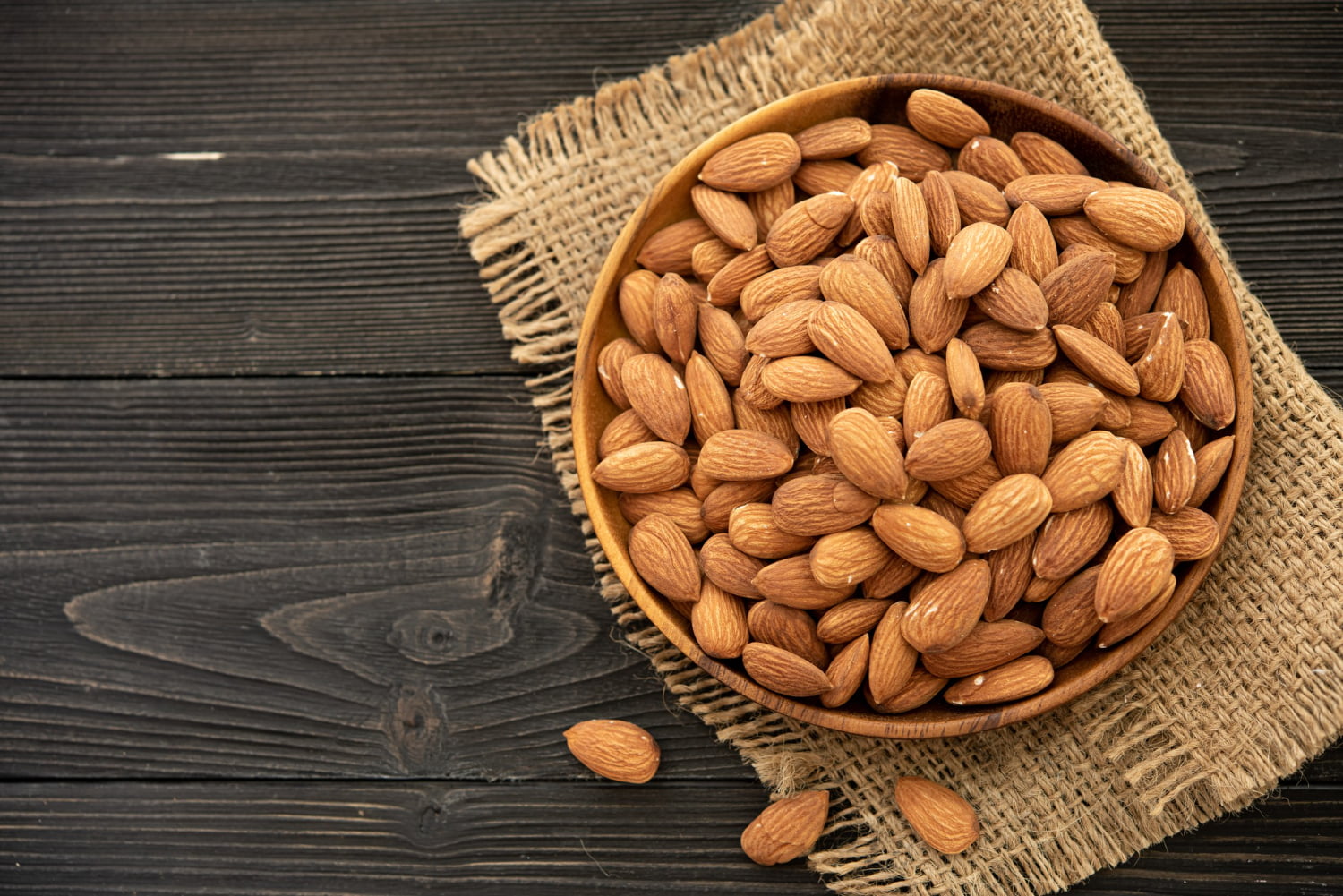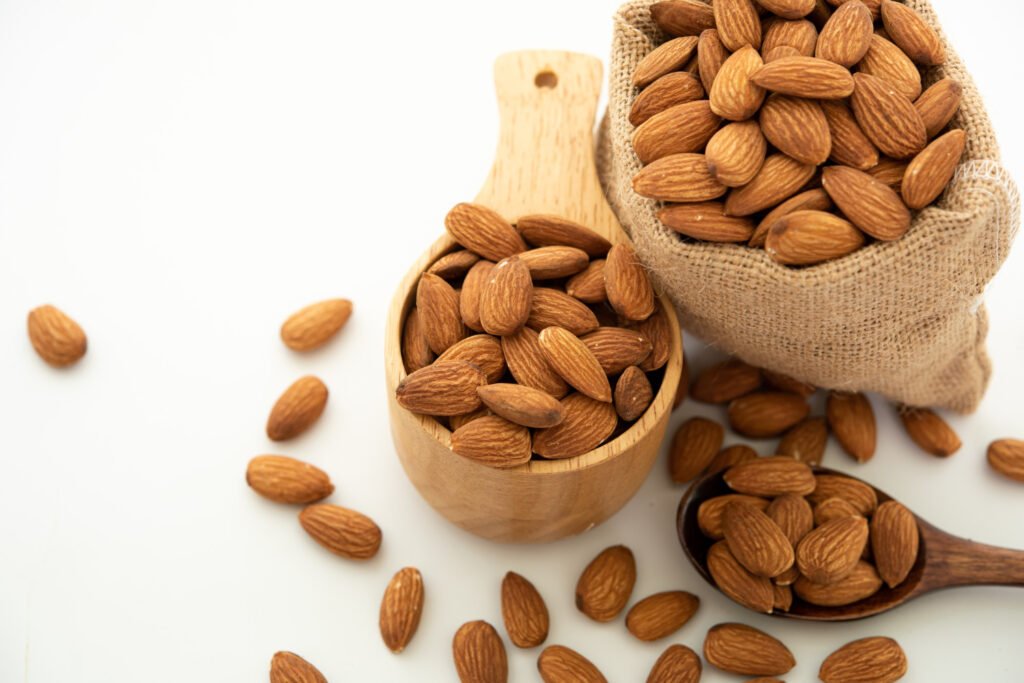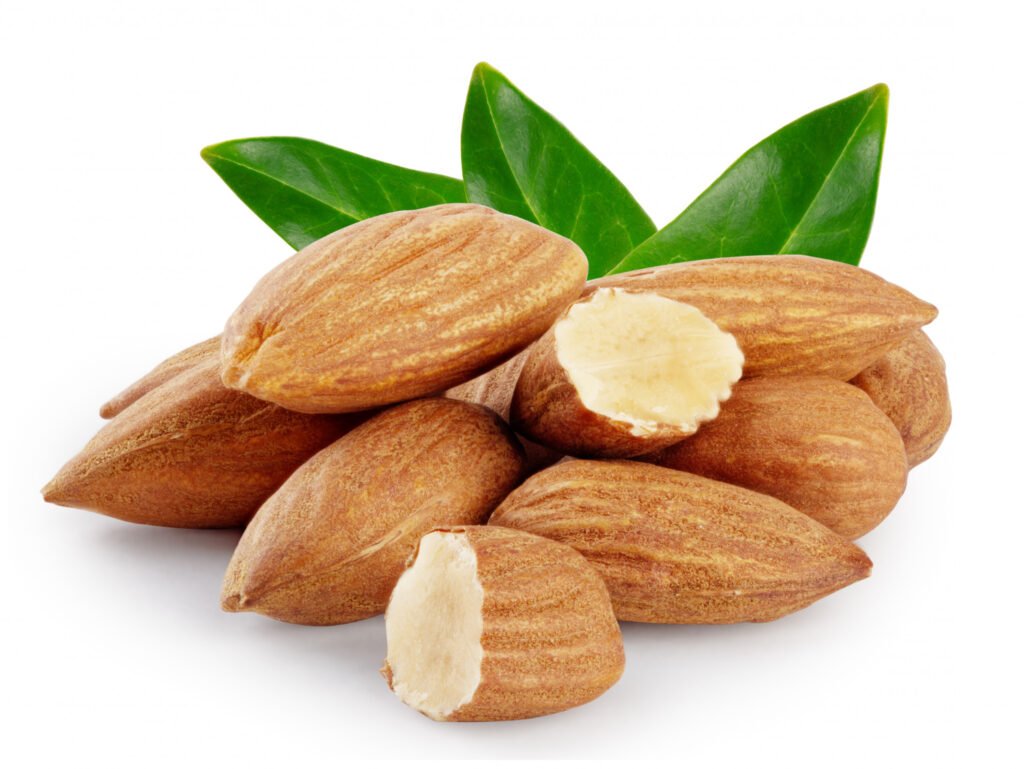Explore Almond Nutrition Facts and Health Benefits

Are you ready to discover the wonders of almonds? Look no further!
In this article, we’ll explore the almond nutrition facts and health benefits that make them a fantastic addition to your diet.
Did you know that just one ounce of almonds contains 164 calories, 14.2 grams of fat, and 6 grams of protein? They’re also packed with essential nutrients like fiber, vitamin E, and magnesium.
So, if you’re looking for a nutritious and delicious snack, keep reading!
Key Takeaways
- Almonds are a good source of protein, fiber, vitamin E, and magnesium.
- Eating almonds may reduce the risk of heart disease and improve diabetes risk and management.
- Almonds support gut health and may provide metabolic benefits such as increased satiety and potential weight loss.
- Individuals with tree nut allergies should be cautious and carry epinephrine at all times.
Nutrition Facts

When it comes to almond nutrition facts, you’ll be pleased to know that one ounce of almonds contains a variety of essential nutrients. Almonds are a great source of protein, fiber, vitamin E, and magnesium. They’re also low in sugar, making them a healthy snack option.
In terms of almond consumption trends, almonds have become increasingly popular due to their numerous health benefits. Almond recipes have gained popularity, with people incorporating them into salads, yogurt, oatmeal, and even using almond meal as a replacement for bread crumbs.
Almond farming practices have evolved to meet the demand, with over 30 varieties of almonds being harvested from August to October in California. Almond processing methods and industry regulations ensure that almonds maintain their nutritional value and quality.
Health Benefits
You can experience numerous health benefits by incorporating almonds into your diet. Almond consumption has been linked to improved heart health, diabetes management, gut health promotion, potential weight loss, and as a source of essential nutrients. Almonds have been shown to reduce the risk of heart disease by lowering LDL cholesterol levels and increasing HDL cholesterol levels. They also have a positive impact on diabetes risk and management, as they help regulate blood sugar levels. Almonds support gut health by promoting microflora richness and diversity. Additionally, almonds may aid in weight loss due to their potential role in increasing satiety and promoting metabolic benefits. Lastly, almonds are a rich source of protein, fiber, vitamin E, and magnesium, making them a nutritious addition to any diet.
| Health Benefits of Almonds |
|---|
| Almond consumption and heart health |
| Almonds and their potential role in weight loss |
Allergies and Adverse Effects

If you have a tree nut allergy, it’s important to be aware of the potential adverse effects of consuming almonds. Almond allergies are common among individuals with tree nut allergies, affecting approximately 0.5 to 1% of the population.
Symptoms of an allergic reaction to almonds can include abdominal pain, itching, and difficulty breathing. In severe cases, immediate medical attention may be required. It’s recommended that individuals with tree nut allergies carry epinephrine at all times.
While almonds are generally safe to consume, they may not be suitable for individuals who are sensitive to salt or have hypertension. It’s also important to note that nut mixes or flavored varieties of almonds may contain high levels of sodium.
If you have almond sensitivity or a tree nut allergy, it’s best to consult with a healthcare professional before including almonds in your diet.
Varieties, Harvest, and Availability
The availability and diversity of almond varieties make them a versatile and accessible option for individuals seeking nutritional benefits. Here are some key points about almond varieties, harvest, and availability:
- Almond varieties: There are over 30 varieties of almonds, with Nonpareil being the most common. Other varieties include Sonora, Aldrich, Winters, and Carmel.
- Almond production: Nonpareil almonds account for 40% of all almond production in California, the largest almond-producing region in the world.
- Almond harvest and availability: Almonds are harvested from August through October in California. They can be found year-round in grocery stores and supermarkets in various forms, including whole, sliced, slivered, and ground.
With a wide range of varieties and a steady supply, almonds are readily available for consumers to enjoy their nutritional benefits. Whether you prefer them whole, sliced, or in other forms, almonds can be easily incorporated into your diet.
Storage, Food Safety, and Culinary Uses
To ensure the freshness and safety of your almonds, it’s important to properly store them, follow food safety guidelines, and explore the various culinary uses for this nutritious nut.
When it comes to storage, almonds in the shell can be stored in the pantry for about six months. If refrigerated, they can last about 16 months, and frozen almonds in the shell can last about 20 months. Almonds without the shell have a shorter shelf life, lasting about four months in the pantry. However, when refrigerated or frozen, they can last longer, up to eight months and 10 months respectively. To prevent spoilage, store almonds in a cool, dry place in airtight containers.
When handling almonds, practice safe food handling practices to avoid cross-contamination.
As for culinary uses, almonds can be enjoyed as a healthy snack in their raw or roasted form. They can also be added to salads, yogurt, or oatmeal for added crunch and flavor. Almond products such as almond butter and almond milk can be used in various recipes, from smoothies to baked goods. Additionally, almond meal can be used as a replacement for bread crumbs or as a coating for fish.
Get creative with almond recipes to incorporate this versatile nut into everyday meals.
Risks and Precautions
When consuming almonds, be aware of potential risks and take necessary precautions. Here are some important considerations:
- Allergy testing: If you have a known tree nut allergy or suspect you may be allergic to almonds, consult an allergist for testing. Symptoms of an allergic reaction can range from mild abdominal pain and itching to more severe reactions requiring immediate medical attention. Carry epinephrine if you have a tree nut allergy.
- Hypertension risks: Almonds are generally safe to consume, but individuals sensitive to salt or those with hypertension should be cautious. Nut mixes or flavored varieties of almonds may contain high levels of sodium, which can negatively impact blood pressure.
- Precautions for pregnant women: Almonds can be a nutritious addition to a pregnant woman’s diet. However, it’s important to follow nutritional guidelines and consume them in moderation. Pregnant women should also be mindful of any potential allergies and consult their healthcare provider if they have any concerns.
Nutritional Value
Continuing from the previous subtopic, let’s delve into the nutritional value of almonds. Almonds aren’t only delicious but also packed with essential nutrients. They’re an excellent source of protein, with one ounce containing 6 grams. Protein is important for muscle repair and growth.
Almonds also provide a substantial amount of fiber, with 3.5 grams in one ounce. Fiber promotes healthy digestion and can help maintain a feeling of fullness. Furthermore, almonds are rich in vitamin E, with 7.3 milligrams in one ounce, which acts as an antioxidant in the body. They also contain significant levels of magnesium, with 76.7 milligrams in one ounce, contributing to bone health and blood pressure regulation.
Due to their high protein and fiber content, almonds play a beneficial role in weight management.
Transitioning into the next section, let’s explore some serving suggestions to incorporate almonds into your diet.
Serving Suggestions

For incorporating almonds into your diet, consider trying them as a topping on your favorite salad or yogurt. Almonds can add a satisfying crunch and an extra burst of flavor to your meals.
Here are some serving suggestions to help you enjoy the versatility of almonds:
- Almond recipes: Explore various almond recipes such as almond-crusted chicken or almond-crusted fish for a healthy and delicious twist.
- Almond snacks: Enjoy a handful of almonds as a nutritious snack between meals. They provide a good source of protein and healthy fats to keep you satiated.
- Almond desserts: Indulge in guilt-free almond desserts like almond flour cookies or almond butter brownies. These treats aren’t only tasty but also offer the nutritional benefits of almonds.
In addition to these suggestions, you can incorporate almonds into smoothies for added creaminess and nutritional value, or use them as a topping for oatmeal, granola, or roasted vegetables. Get creative and explore the endless possibilities of incorporating almonds into your meals.
Frequently Asked Questions
Can Almonds Be Consumed by Individuals With Nut Allergies?
Yes, individuals with nut allergies should avoid consuming almonds. Symptoms of an allergic reaction to almonds can include abdominal pain, itching, and difficulty breathing. Consult an allergist for testing and diagnosis. Consider alternative nuts or nut-free almond-flavored recipes for those with allergies.
How Long Can Almonds Be Stored in the Freezer?
Almonds can be stored in the freezer for up to 20 months, preserving their freshness and preventing freezer burn. It’s an optimal storage method, especially if you want to extend their shelf life.
Are There Any Specific Varieties of Almonds That Are Recommended for Baking?
The best almond varieties for snacking and baking include Nonpareil, Sonora, Aldrich, Winters, and Carmel. Almond flour is a great alternative in baking recipes, and almond butter and extract can add delicious flavor to your baked goods.
Can Almond Milk Be Used as a Substitute for Cow’s Milk in Recipes?
Yes, almond milk can be used as a substitute for cow’s milk in recipes. It offers a creamy texture and nutty flavor. Almond milk is a popular alternative for those with lactose intolerance or following a plant-based diet.
Are There Any Potential Side Effects of Consuming Too Many Almonds?
Excessive almond consumption can lead to almond overdose, almond nutrient overdose, and almond toxicity. Potential side effects may include abdominal discomfort, bloating, and diarrhea. It is important to consume almonds in moderation to avoid these adverse effects.
Conclusion
In conclusion, almonds are a nutritious and delicious snack that can be a great addition to your diet. Packed with essential nutrients like fiber, vitamin E, and magnesium, they offer numerous health benefits such as improved heart health, cholesterol levels, and diabetes management.
However, it’s important to be aware of any allergies or sensitivities to almonds. With proper storage and culinary uses, almonds can be enjoyed in a variety of ways.
So why not incorporate this wonderful nut into your daily routine for a healthy and tasty treat?

Author
Years ago, the spark of my life’s passion ignited in my mind the moment I stepped into the local gym for the first time. The inaugural bead of perspiration, the initial endeavor, the very first surge of endorphins, and a sense of pride that washed over me post-workout marked the beginning of my deep-seated interest in strength sports, fitness, and sports nutrition. This very curiosity blossomed rapidly into a profound fascination, propelling me to earn a Master’s degree in Physical Education from the Academy of Physical Education in Krakow, followed by a Sports Manager diploma from the Jagiellonian University. My journey of growth led me to gain more specialized qualifications, such as being a certified personal trainer with a focus on sports dietetics, a lifeguard, and an instructor for wellness and corrective gymnastics. Theoretical knowledge paired seamlessly with practical experience, reinforcing my belief that the transformation of individuals under my guidance was also a reflection of my personal growth. This belief holds true even today. Each day, I strive to push the boundaries and explore new realms. These realms gently elevate me to greater heights. The unique combination of passion for my field and the continuous quest for growth fuels my drive to break new ground.















